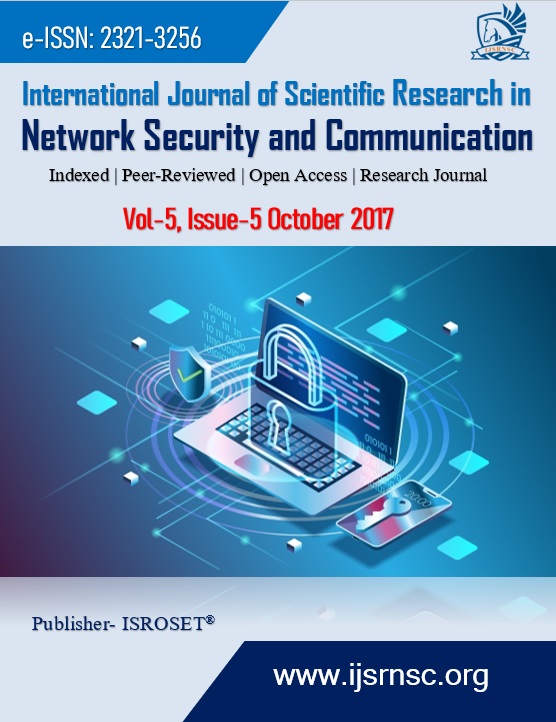Drop of RERR Leads Routing Loop in AODV
Keywords:
AODV, MANETs, REQ, RREP, RERR, Loop Formation, Routing ProtocolsAbstract
Ad-hoc networks are infrastructure less multihop wireless network. In ad-hoc network routes are provided by wireless nodes. Wireless nodes are free to move randomly on any direction with random speed. Ad-hoc networks with mobility are considered as MANETs. In ad-hoc network each node can act as a hop and router itself or both at the same time. Which make routing difficult, to deal with this problem routing protocol required. Ad-hoc On-Demand Distance Vector (AODV) is one of the simplest, efficient, and effective reactive routing protocol developed for MANETs. To maintain routes in wireless ad-hoc networks. AODV use some control messages to manage communication in between nodes. Route Request Message (RREQ) disseminated along with source sequence number through a node to discover a route, Route Reply Message (RREP) uni-casted along with destination sequence number back to source node, HELLO message used to detect and monitor link and Route Error Message (RERR) disseminated to inform all nodes when link failure occur in the network. To keep route information readily available and low routing overhead, AODV maintain route caching but some times cache not removed due to drop, collision and failure of control messages and route cache become stale. This stale cache leads routing loop in ad-hoc network. After detailed study of RFC 3561 & most of the research work done in past. It is commonly known in AODV routing protocol that sequence number are sufficient to protect networks from count to infinity problem. But in this research work implementation to be done to provide a valid proof of routing loop on the simulator. The purpose of this research is to identify flaw so in future we can get more reliable routing protocol.
References
N. H. Saeed, M. F. Abbod, and H. S. Al-Raweshidy. Manet routing protocols tax- onomy. In 2012 International Conference on Future Communication Networks, pages 123128, April 2012.
K. Subramanian, R. Gnanakumaran , "Analysis of Power Complexity in Existing Algorithms Against Ad-Hoc On demand Distance Vector Routing Protocol (AODV)", International Journal of Computer Sciences and Engineering, Vol.4, Issue.12, pp.36-45, 2016.
Charles E. Perkins and Pravin Bhagwat. Highly dynamic destinationsequenced distance-vector routing (dsdv) for mobile computers. In Proceedings of the Conference on Communications Architectures, Protocols and Applications, SIGCOMM 94, pages 234244, New York, NY, USA, 1994. ACM.
P.W. Dkhar, R. Khongthaw, "Survey Paper on DSDV and AODV Routing Protocol of MANET", International Journal of Computer Sciences and Engineering, Vol.5, Issue.3, pp.69-74, 2017.
P. Mutalik, Nagaraj S, Vedavyas J, R. V. Biradar, and V. G. C.
Patil. A comparative study on aodv, dsr and dsdv routing protocols for intelligent transportation system (its) in metro cities for road traffic safety using vanet route traffic analysis (vrta). In 2016 IEEE International Conference on Advances in Electronics, Communication and Computer Technology (ICAECCT), pages 383386, Dec 2016.
C. Mbarushimana and A. Shahrabi. Comparative study of reactive and proactive routing protocols performance in mobile ad hoc networks. In Advanced Information Networking and Applications Workshops, 2007, AINAW ’07. 21st International Conference on , volume 2, pages 679–684, May 2007.
H. Rangarajan and J. J. Garcia-Luna-Aceves, ”Achieving loop-free incremental routing in ad hoc networks,” Proceedings. ISCC 2004. Ninth International Symposium on Computers and Communications (IEEE Cat. No.04TH8769), 2004, pp. 182-187 Vol.1. doi:10.1109/ISCC.2004.1358402
Leena Pal, Pradeep Sharma, Netram Kaurav and Shivlal Mewada, "Performance Analysis of Reactive and Proactive Routing Protocols for Mobile Ad-hoc –Networks", International Journal of Scientific Research in Network Security and Communication, Vol.1, Issue.5, pp.1-4, 2013.
M. Velempini and M. E. Dlodlo. A virtual ad hoc routing algorithm for manets. In The 2nd International Conference on Wireless Broadband and Ul-tra Wideband Communications (AusWireless 2007), pages 2222, Aug 2007.
Harishbabu.Kalidasu ,Srikanth.Gummadi, Regula Srilakshmi, Caching Strategies In Manet Using Dsr And Aodv Routing Protocols, Sep-13 Vol.1 Issue.9 , International Journal on Recent and Innovation Trends in Computing and Communication (IJRITCC), ISSN: 2321-8169, PP: 697-699
Rob van Glabbeek, Peter Hofner, Wee Lum Tan, and Marius Portmann. Sequence numbers do not guarantee loop freedom: Aodv can yield routing loops. In Proceedings of the 16th ACM International Conference on Modeling, Analysis & Simulation of Wireless and Mobile Systems, MSWiM 13, pages 91100, New York, NY, USA, 2013. ACM.
M. Zhou, H. Yang, X. Zhang and J. Wang, ”The proof of AODV loop freedom,” 2009 International Conference on Wireless Communications Signal Processing, Nanjing, 2009, pp. 1-5. doi: 10.1109/WCSP.2009.5371479
Umesh Kumar Singh, Jalaj Patidar and Kailash Chandra Phuleriya, "On Mechanism to Prevent Cooperative Black Hole Attack in Mobile Ad Hoc Networks", International Journal of Scientific Research in Computer Science and Engineering, Vol.3, Issue.1, pp.11-15, 2015.
S. Chettibi, Y. Labeni, and A. Boulkour. Trace file analyzer for adhoc routing protocols simulation with ns2. In 2015 First International Conference on New Technologies of Information and Communication (NTIC) , pages 16, Nov 2015.
J. Zhang,W. Li, D. Cui, X. Zhao, and Z. Yin. The ns2-based simulation and research on wireless sensor network route protocol. In 2009 5th International Conference on Wireless Communications, Networking and Mobile Computing , pages 14, Sept 2009.
Downloads
Published
How to Cite
Issue
Section
License

This work is licensed under a Creative Commons Attribution 4.0 International License.
Authors contributing to this journal agree to publish their articles under the Creative Commons Attribution 4.0 International License, allowing third parties to share their work (copy, distribute, transmit) and to adapt it, under the condition that the authors are given credit and that in the event of reuse or distribution, the terms of this license are made clear.









